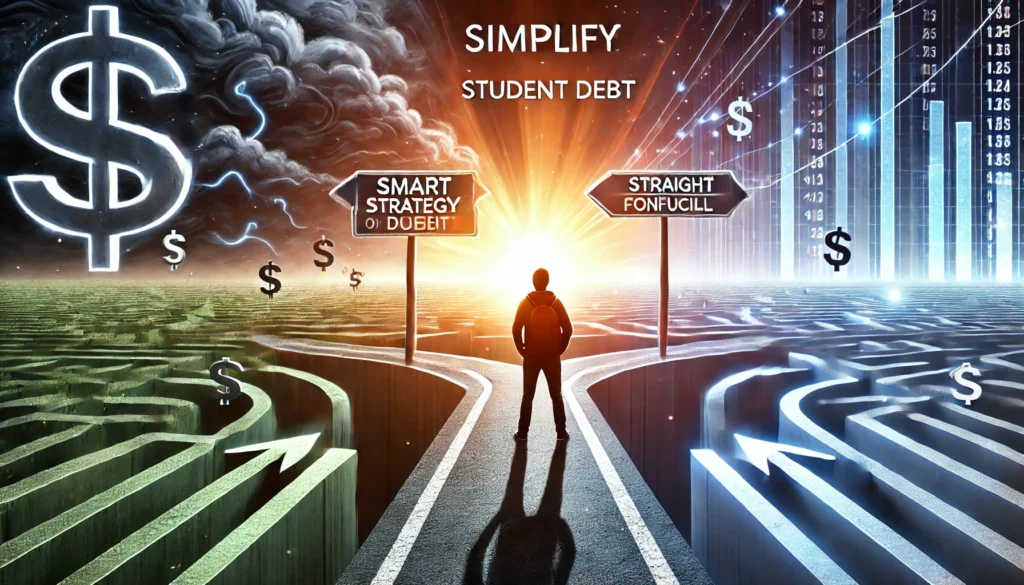Understanding the Federal Direct Consolidation Loan
Managing student loan debt can be overwhelming, especially for graduates juggling multiple monthly payments with different interest rates and repayment terms. A Federal Direct Consolidation Loan offers a streamlined solution by combining multiple federal student loans into a single, manageable loan with a fixed interest rate. This consolidation process is facilitated through the U.S. Department of Education, providing borrowers with a simplified repayment structure that may also open pathways to additional repayment options, such as income-driven repayment plans and loan forgiveness programs.
You may also like: Unlocking the Benefits of Refinancing: How Smart Strategies Can Save You Thousands on Your Mortgage
For those struggling with multiple federal student loans, understanding the nuances of the federal direct consolidation loan program is essential. Unlike refinancing, which often requires switching to a private lender, a direct consolidation loan ensures that borrowers retain their federal loan benefits, including eligibility for Public Service Loan Forgiveness (PSLF) and deferment or forbearance options. The key question many borrowers ask is: Can I consolidate a consolidated student loan? The answer depends on the circumstances, as some loans may be reconsolidated under specific conditions, particularly if new eligible loans are added.
The Benefits of Consolidating Federal Student Loans
Opting for a direct consolidation loan provides multiple advantages beyond simply reducing the number of payments. Borrowers may benefit from a lower fixed interest rate, as the new interest rate is determined by taking the weighted average of the original loans’ interest rates, rounded up to the nearest one-eighth of a percent. This prevents borrowers from facing drastic increases in interest, which can be a risk in private refinancing options.
Another significant advantage is the potential for extended repayment terms. By consolidating, borrowers can qualify for repayment terms ranging from 10 to 30 years, depending on their total loan balance. This extension can significantly reduce monthly payments, freeing up cash flow for other financial goals. However, it is crucial to weigh this benefit against the potential for increased total interest costs over the life of the loan.
Moreover, a federal loan consolidation allows borrowers to access certain repayment plans that might not have been available with their original loans. For example, Parent PLUS loans are only eligible for Income-Contingent Repayment (ICR) once consolidated. Additionally, borrowers who consolidate loans that are in default can regain eligibility for federal financial aid and remove the default status from their credit reports, improving their financial standing.

How to Apply for a Direct Consolidation Loan
The direct consolidation loan application process is relatively straightforward and can be completed online through the Federal Student Aid (FSA) website. The direct consolidation loan application and promissory note must be carefully reviewed before submission to ensure that all loan details are accurate. Applicants will be required to select a loan servicer, such as Nelnet, which handles the administration and repayment processing.
One of the most common concerns applicants have is: Can I cancel my loan consolidation application? The answer is yes, as long as the process has not been finalized. Borrowers should act promptly if they decide that consolidation is not the right choice for them.
For those wondering, how do I know if my student loans are consolidated?, the answer lies in reviewing loan details on the FSA website or contacting the assigned loan servicer. Borrowers should ensure that all expected loans are included in the consolidation and that they understand the new terms before proceeding.

Federal Direct Consolidation Loan and Loan Forgiveness Programs
A federal direct consolidation loan can impact eligibility for various loan forgiveness programs, making it a strategic move for borrowers seeking Public Service Loan Forgiveness (PSLF) or Income-Driven Repayment (IDR) forgiveness. Consolidation can reset the clock on payments toward PSLF, which is crucial for borrowers who have already made qualifying payments. However, for those starting fresh in public service roles, consolidation may be beneficial to simplify loan tracking and payments.
Additionally, borrowers may wonder, what does paid in full by consolidation mean? This phrase appears on credit reports and loan documents, signifying that the original loans have been paid off through the new direct consolidation loan. While this does not erase debt, it indicates that loans are successfully merged into a single repayment structure.

Considerations Before Consolidating Student Loans
While consolidation can provide relief, it is not always the right decision for every borrower. Those with federal Perkins loans, for example, should be cautious, as consolidation may result in the loss of unique benefits, such as loan cancellation programs for certain public service professions. The question can you consolidate unsubsidized and subsidized loans together? often arises, and the answer is yes, but borrowers should be aware that doing so will result in a loss of separate subsidized loan benefits, such as interest subsidies during deferment periods.
Furthermore, borrowers applying for loan forgiveness consolidation should understand that consolidation does not erase loan balances—it merely restructures them. If pursuing PSLF or IDR forgiveness, borrowers should carefully evaluate whether consolidating will disrupt their progress toward forgiveness milestones.
Frequently Asked Questions (FAQ)
Can I cancel my loan consolidation application after submission?
Yes, you can cancel your loan consolidation application, but the process depends on the lender and the type of consolidation. For federal loan consolidation, you must contact the servicer before the processing is complete. If your direct consolidation loan application has been approved and finalized, cancellation becomes difficult. Borrowers using Nelnet loan consolidation should reach out to their representative as soon as possible if they have second thoughts. Understanding the fine print of your dept education loan consolidation terms before applying can prevent the need for cancellation.
How do I know if my student loans are consolidated?
You can confirm if your student loans are consolidated by reviewing your loan status through your Federal Student Aid (FSA) account. Additionally, your loan servicer, whether it be through Nelnet debt consolidation or another provider, should provide details on your consolidation application. If you see a federal direct consolidation loan listed on your loan summary, your loans have been successfully consolidated. Borrowers who have their student loans paid in full by consolidation should also receive confirmation. If you’re unsure, contacting the department of education debt consolidation office can provide clarity.
Can you consolidate unsubsidized and subsidized loans together?
Yes, you can consolidate unsubsidized and subsidized loans together under a federal direct consolidation loan. However, while they can be combined into a single payment, the interest rates and terms might differ. The DL consolidation unsubsidized portion will continue accruing interest during deferment, whereas the subsidized portion may qualify for interest benefits. Understanding how interest accrues on these loans can help you decide whether a federal consolidation loan application is the best option. Always verify the potential impact on loan forgiveness consolidation programs before proceeding.
What does ‘paid in full by consolidation’ mean?
When you see ‘paid in full by consolidation’ on your loan account, it means that your original loans were fully settled through a direct consolidation loan. This doesn’t mean the debt is eliminated, but rather that a new loan has replaced the previous ones. This new federal direct consolidation loan program may have different repayment terms, interest rates, or loan forgiveness options. Borrowers who consolidate education loans should be aware that their repayment timeline might be reset. Always check how your new loan impacts your repayment progress and loan forgiveness eligibility.
Can I consolidate a consolidated student loan?
Yes, but with restrictions. If you previously consolidated under a federal direct consolidation loan, you can only reconsolidate in certain circumstances. For instance, if you acquire additional federal loans or want to qualify for a different repayment or loan forgiveness consolidation program, reconsolidation may be an option. Borrowers using Nelnet consolidation services should inquire about specific conditions under which reconsolidation is permitted. If you’re uncertain about your eligibility, checking with loan consolidation gov resources can provide guidance. Carefully evaluating the impact on interest rates and repayment terms before reconsolidating is crucial.
How does consolidation affect my eligibility for loan forgiveness?
Loan consolidation can impact eligibility for loan forgiveness programs in both positive and negative ways. If you consolidate education loans that were already making progress toward Public Service Loan Forgiveness (PSLF), your qualifying payment count may reset. However, switching to a federal direct consolidation loan program may make certain loans eligible for forgiveness programs they previously did not qualify for. Borrowers considering dept education loan consolidation should assess their long-term forgiveness strategy before consolidating. If you have federal Perkins loan consolidation, understand that these loans might lose some benefits when consolidated. Consulting with a student loan expert before proceeding is advisable.
What should I consider before submitting a federal consolidation loan application?
Before submitting a federal consolidation loan application, evaluate the impact on interest rates, repayment terms, and potential loan forgiveness. A direct consolidation loan application and promissory note will commit you to new repayment terms, so understanding your obligations is critical. Borrowers using FSA consolidation should ensure they are not losing valuable benefits, such as interest subsidies or PSLF eligibility. Government loans for loan consolidation may provide relief but could also extend the repayment term, leading to more interest paid over time. Reviewing your options with a financial advisor can help you make an informed decision.
How do government loans for loan consolidation compare to private consolidation options?
Government loans for loan consolidation offer fixed interest rates, income-driven repayment options, and loan forgiveness programs, whereas private consolidation may have variable rates and fewer benefits. The federal direct consolidation loan program ensures that borrowers retain federal protections, while private lenders might offer lower interest rates but with stricter terms. Borrowers considering Nelnet loan consolidation should compare benefits like deferment, forbearance, and forgiveness eligibility before deciding. A consolidation application through a private lender may limit your ability to access federal repayment plans. Understanding the trade-offs can help borrowers choose the best path for their financial situation.
What happens if I submit multiple consolidation applications?
Submitting multiple consolidation applications can lead to processing delays and confusion. If you apply for a direct consolidation loan application while another is still being processed, the earlier application may be canceled automatically. Borrowers should ensure that their federal consolidation loan application is correctly submitted and that they meet all eligibility requirements before reapplying. If you’re unsure whether your application was processed, checking with FSA loan consolidation resources can provide clarity. Keeping track of your applications and corresponding servicers can prevent unnecessary delays in loan consolidation gov processes.
Does consolidation impact my credit score?
In most cases, consolidation has a minimal direct impact on your credit score. A federal direct consolidation loan does not create a hard inquiry on your credit report, unlike private refinancing. However, consolidating education loans can indirectly affect your credit if it alters your debt-to-income ratio or changes your repayment history. Borrowers using Nelnet debt consolidation should ensure that they continue making payments on their existing loans until the new loan is finalized. Proper financial planning before applying for a federal consolidation loan application can help maintain a strong credit profile.
Conclusion
A Federal Direct Consolidation Loan is a valuable tool for simplifying student debt repayment, providing borrowers with more manageable payment structures and access to additional federal benefits. However, before proceeding with a consolidation application, borrowers should carefully evaluate the impact on interest rates, repayment terms, and eligibility for forgiveness programs. By making an informed decision, student loan borrowers can optimize their repayment strategy and move toward financial stability with confidence.
student loan repayment, student loan consolidation, managing student debt, public service loan forgiveness, income-driven repayment, federal student aid, student loan forgiveness, debt management strategies, financial planning for graduates, education loan refinancing, direct loan consolidation benefits, student debt relief options, federal student loan servicers, student loan refinancing alternatives, loan forgiveness eligibility, financial literacy for students, paying off student loans efficiently, debt relief programs, government-backed loan consolidation, student loan repayment strategies
Further Reading:
Top Strategies for Smart Student Loan Repayment within Your Business for Enhanced Asset Protection
Navigating Student Loans: Smart Strategies for Indian Students
10 Ways to Reduce Student Loan Debt
The information provided in this article is for general informational purposes only and is not intended to constitute financial, investment, legal, tax, or other professional advice. The content should not be relied upon for making any financial or investment decisions. Readers are encouraged to consult with licensed professionals, such as financial advisors, attorneys, or tax experts, to obtain personalized advice tailored to their individual circumstances. The author and publisher disclaim any liability for any actions taken or not taken based on the information provided in this article.





